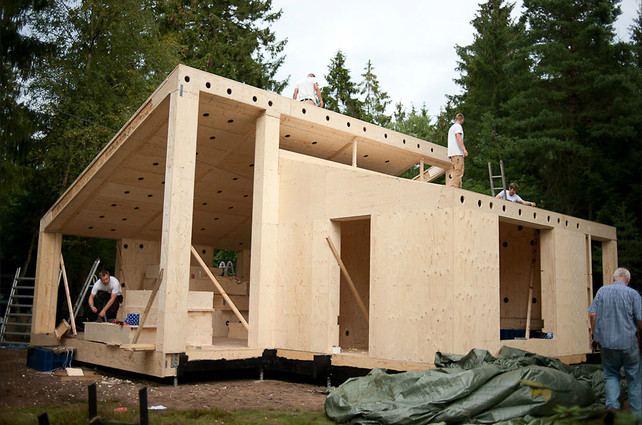Snap Fit Construction from Facit Homes

Facit Homes housing unit under construction. Courtesy of Facit Homes.
Latest News
August 20, 2012
Most people had some at least one set Lego or Lincoln Logs when they were kids, pieces lying about the house waiting to ambush anyone with bare feet. Part of what made those building blocks so interesting to multiple generations was the simplicity of design. Pretty much anything you could imagine, you could build, assuming you didn’t mind it having square edges.
Rapid manufacturing processes have led to improvements in time to market for any number of industries. Constructing a building has benefited from some improvements, but can still take many months to construct. A few enterprising inventors have suggested using massive 3D printers for construction, but it hasn’t really seemed to have caught on quite yet. What if we could use something like Lego to speed up construction?
Facit Homes may not have been inspired by Lego, but its construction process bears some resemblance. Instead pounding nails, buildings constructed by the company are snap fit together. In place of pouring concrete for a foundation, screw piles measuring from 12 to 20 ft. are embedded into the ground, leaving a foot or so of clearance under the building.
The company calls its construction technique “D-process” and it begins by working with a client to determine their exact needs. Every inch of the building to be constructed (down to electrical sockets) is built using CAD software. The design is then fabricated from plywood using a CNC miller. The entire construction of a 1,250-sq-ft. home was completed in just six weeks.
“No component of the construction is heavier than two men are able to carry … and the house can be built without the use of cranes or heavy machinery,” says Frederik Agdrup, who designed the house.
Facit Homes also claims its D-process creates more sustainable structures. According to the company, typical CO2 emissions from one of its buildings is less than 10,000 tons/year, while a building constructed using more traditional methods produces over 50,000. Excess wood from construction is gathered up and shipped back to sawmills to be used as fuel.
Below you’ll find a video from Facit Homes describing its D-process.
Sources: FastCompany, Facit Homes
Subscribe to our FREE magazine, FREE email newsletters or both!
Latest News
About the Author
John NewmanJohn Newman is a Digital Engineering contributor who focuses on 3D printing. Contact him via [email protected] and read his posts on Rapid Ready Technology.
Follow DE






